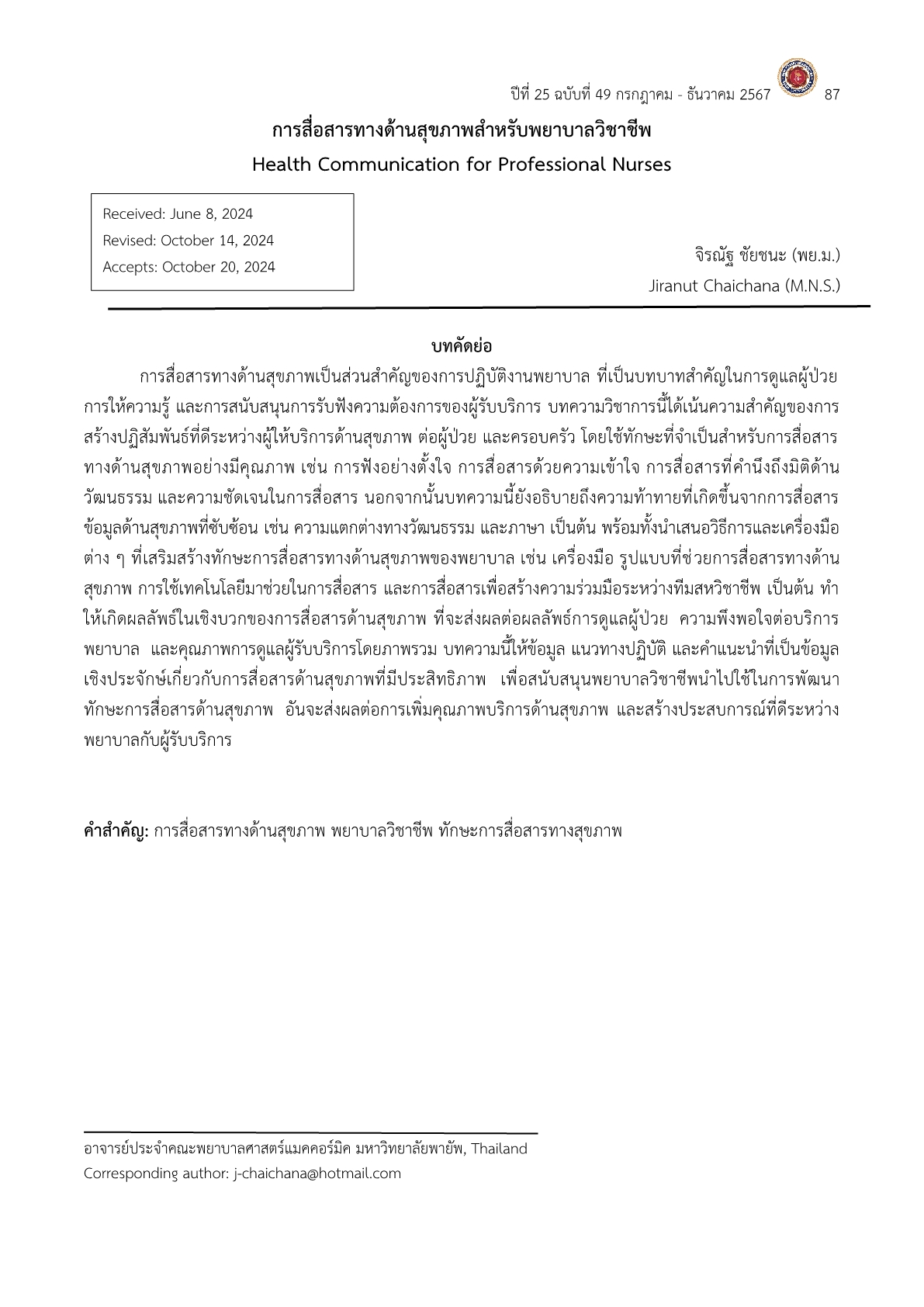การสื่อสารทางด้านสุขภาพสำหรับพยาบาลวิชาชีพ
คำสำคัญ:
การสื่อสารทางด้านสุขภาพ, พยาบาลวิชาชีพ, ทักษะการสื่อสารทางสุขภาพบทคัดย่อ
การสื่อสารทางด้านสุขภาพเป็นส่วนสำคัญของการปฏิบัติงานพยาบาล ที่เป็นบทบาทสำคัญในการดูแลผู้ป่วย การให้ความรู้ และการสนับสนุนการรับฟังความต้องการของผู้รับบริการ บทความวิชาการนี้ได้เน้นความสำคัญของการสร้างปฏิสัมพันธ์ที่ดีระหว่างผู้ให้บริการด้านสุขภาพ ต่อผู้ป่วย และครอบครัว โดยใช้ทักษะที่จำเป็นสำหรับการสื่อสารทางด้านสุขภาพอย่างมีคุณภาพ เช่น การฟังอย่างตั้งใจ การสื่อสารด้วยความเข้าใจ การสื่อสารที่คำนึงถึงมิติด้านวัฒนธรรม และความชัดเจนในการสื่อสาร นอกจากนั้นบทความนี้ยังอธิบายถึงความท้าทายที่เกิดขึ้นจากการสื่อสารข้อมูลด้านสุขภาพที่ซับซ้อน เช่น ความแตกต่างทางวัฒนธรรม และภาษา เป็นต้น พร้อมทั้งนำเสนอวิธีการและเครื่องมือต่าง ๆ ที่เสริมสร้างทักษะการสื่อสารทางด้านสุขภาพของพยาบาล เช่น เครื่องมือ รูปแบบที่ช่วยการสื่อสารทางด้านสุขภาพ การใช้เทคโนโลยีมาช่วยในการสื่อสาร และการสื่อสารเพื่อสร้างความร่วมมือระหว่างทีมสหวิชาชีพ เป็นต้น ทำให้เกิดผลลัพธ์ในเชิงบวกของการสื่อสารด้านสุขภาพ ที่จะส่งผลต่อผลลัพธ์การดูแลผู้ป่วย ความพึงพอใจต่อบริการพยาบาล และคุณภาพการดูแลผู้รับบริการโดยภาพรวม บทความนี้ให้ข้อมูล แนวทางปฏิบัติ และคำแนะนำที่เป็นข้อมูลเชิงประจักษ์เกี่ยวกับการสื่อสารด้านสุขภาพที่มีประสิทธิภาพ เพื่อสนับสนุนพยาบาลวิชาชีพนำไปใช้ในการพัฒนาทักษะการสื่อสารด้านสุขภาพ อันจะส่งผลต่อการเพิ่มคุณภาพบริการด้านสุขภาพ และสร้างประสบการณ์ที่ดีระหว่างพยาบาลกับผู้รับบริการ
เอกสารอ้างอิง
กฤดิญาดา เกื้อวงศ์ และอารีย์วรรณ อ่วมตานี. (2563). ประสบการณ์การเป็นพยาบาลจบใหม่ที่ปฏิบัติงานในหอผู้ป่วยวิกฤตโรงพยาบาลมหาวิทยาลัยจุฬาลงกรณ์มหาวิทยาลัย. วารสารพยาบาลสภากาชาดไทย, 13 (1), 90-101.
จิรณัฐ ชัยชนะ วโรดม เสมอเชื้อ ปรมาภรณ์ นิรมล และ ขัตติยาพร คนเที่ยง (2023). ผลของการใช้รูปแบบ SEGUE ต่อทักษะการสื่อสารทางสุขภาพของนักศึกษาพยาบาล. วารสารคณะพยาบาลศาสตร์ มหาวิทยาลัยสยาม, 23(45), 39–53.
จุไรรัตน์ ดวงจันทร์. (2563). การสื่อสารเพื่อส่งต่อข้อมูลทางการพยาบาลด้วยเทคนิคเอสบาร์. วารสารคณะพยาบาลศาสตร์ มหาวิทยาลัยสยาม, 21(41), 91–103.
สภาการพยาบาล. (2566). คู่มือพยาบาลใหม่. ปทุมธานี: วีอินดี้ดีไซน์.
อติญาณ์ ศรเกษตริน ดาราวรรณ รองเมือง และรุ่งนภา จันทรา. (2562). การศึกษาพยาบาลในศตวรรษที่ 21: สมรรถนะและบทบาทของอาจารย์พยาบาล. วารสารพยาบาลทหารบก, 20(1), 12-20.
Afriyie, D. (2020). Effective communication between nurses and patients: an evolutionary concept analysis. British Journal of Community Nursing, 25(9), 438-445, https://doi.org/10.12968/bjcn.2020.25.9.438
Andreadis, K., Muellers, K., Ancker, J. S.,Horowitz, C., Kaushal, R., & Lin, J. J. (2023). Telemedicine Impact on the Patient-Provider Relationship in Primary Care During the COVID-19 Pandemic. Medical care, 61(Suppl 1), S83–S88. https://doi.org/10.1097/MLR.0000000000001808
Bandura, A. (2006). Toward a psychology of human agency. Perspectives on psychological science, 1(2), 164-180.
Blazin, L. J., Sitthi-Amorn, J., Hoffman, J. M., & Burlison, J. D. (2020). Improving Patient Handoffs and Transitions through Adaptation and Implementation of I-PASS Across Multiple Handoff Settings. Pediatric quality & safety, 5(4), e323. https://doi.org/10.1097/pq9.0000000000000323
Carpenter, C. J. (2010). A meta-analysis of the effectiveness of Health Belief Model variables in predicting behavior. Health communication, 25(8), 661-669.
Forde-Johnston, C., Butcher, D., & Aveyard, H. (2023). An integrative review exploring the impact of Electronic Health Records (EHR) on the quality of nurse-patient interactions and communication. Journal of advanced nursing, 79(1), 48–67. https://doi.org/10.1111/jan.15484
Gamor, N., Dzansi, G., Konlan, K. D., & Abdulai, E. (2023). Exploring social media adoption by nurses for nursing practice in rural Volta, Ghana. Nursing open, 10(7), 4432–4441. https://doi.org/10.1002/nop2.1685
Jones, A., & Bentham, P. (2018). Communication skills: A guide for health care workers. British Journal of Healthcare Assistants, 12(3), 140–144. doi:10.12968/bjha.2018.12.3.140
Kwame, A., & Petrucka, P. M. (2021). A literature based study of patient-centered care and communication in nurse-patient interactions: barriers, facilitators, and the way forward. BMC nursing, 20(1), 158.
Lee, H. (2020). The role of nurses in health communication. Journal of Community Health Nursing, 37(2), 102–108. doi:10.1080/07370016.2020.1730415
Scott, A. M., Coolidge, A. A., Donovan, E. E., Kerr, A. M., Longtin, K., Thompson, C. M., Ring, D., & Van Scoy, L. J. (2024). The Impact of Health Communication Research on Medical and Health Professional Education and Training. Health communication, 1–8. Advance online publication. https://doi.org/10.1080/10410236.2024.2326258
Wang, W., Shen, J., Greene, W. B., Ren, D., & Sherwood, P. (2022). The effect of ISBARR on knowledge of and attitudes about interprofessional communication skills among Chinese undergraduate nursing students. Nurse education today, 109, 105207. https://doi.org/10.1016/j.nedt.2021.105207
Wianti, A., & Koswara, R. (2021). Description of the Implementation of Sbar Communication. Asian Community Health Nursing Research, 9-9. https://doi.org/10.29253/achnr.2021.3951
WHO. (2022). Health communication. Retrieved 27Jan 2024, fromhttps://cdn.who.int/media/ docs/default-source/wpro-documents/regional-committee/session-74/wpr-rc74-agenda-13-communication-for healthannex.pdf?sfvrsn=47febfd6_1&download=true
Young, S., & Guo, K. L. (2020). Cultural diversity training: the necessity of cultural competence for health care providers and in nursing practice. The health care manager, 39(2), 100-108.

ดาวน์โหลด
เผยแพร่แล้ว
รูปแบบการอ้างอิง
ฉบับ
ประเภทบทความ
สัญญาอนุญาต
ลิขสิทธิ์ (c) 2024 วารสารพยาบาลศาสตร์ มหาวิทยาลัยสยาม

อนุญาตภายใต้เงื่อนไข Creative Commons Attribution-NonCommercial-NoDerivatives 4.0 International License.
เนื้อหาและข้อมูลที่เผยแพร่ในวารสารพยาบาลศาสตร์ มหาวิทยาลัยสยามถือเป็นข้อคิดเห็นและความรับผิดชอบของผู้นิพนธ์บทความโดยตรง
บทความ เนื้อหา ข้อมูล รูปภาพ ฯลฯ ที่ได้รับการเผยแพร่ในวารสารพยาบาลศาสตร์ มหาวิทยาลัยสยาม ถือเป็นลิขสิทธิ์ของวารสารพยาบาลศาสตร์ มหาวิทยาลัยสยาม หากบุคคลหรือหน่วยงานใดต้องการนำทั้งหมดหรือส่วนหนึ่งส่วนใดไปเผยแพร่หรือเพื่อกระทำการใด ๆ จะต้องอ้างอิงวารสารพยาบาลศาสตร์ มหาวิทยาลัยสยามทุกครั้ง


